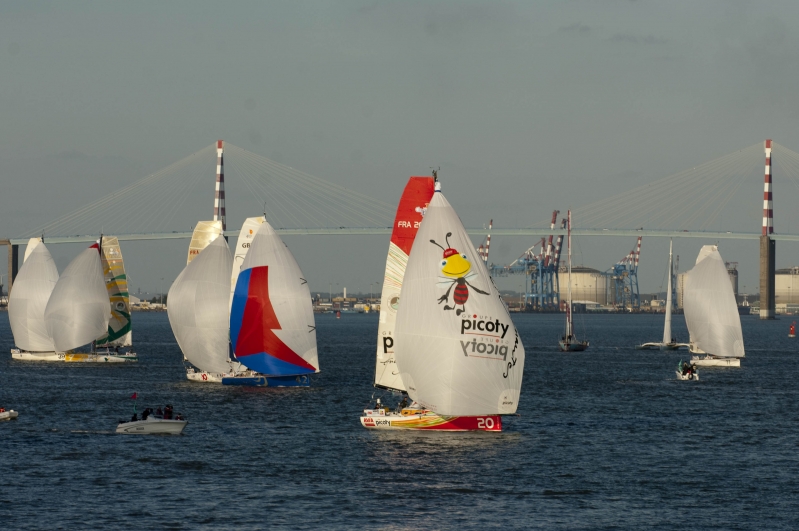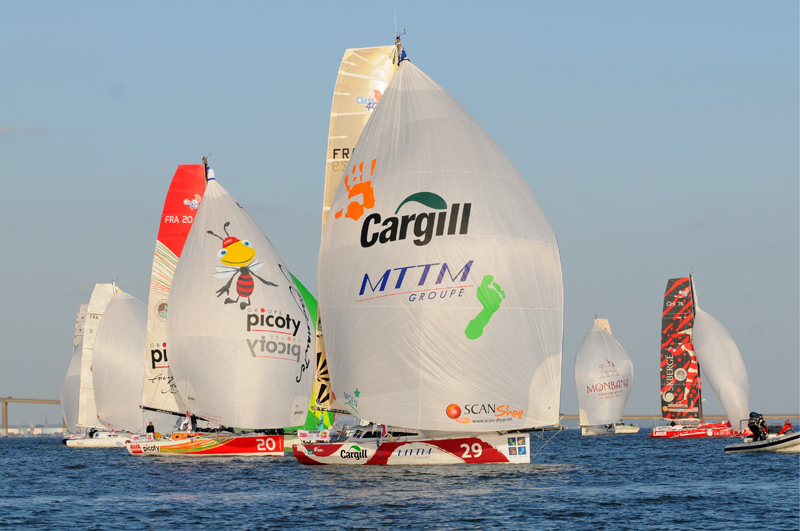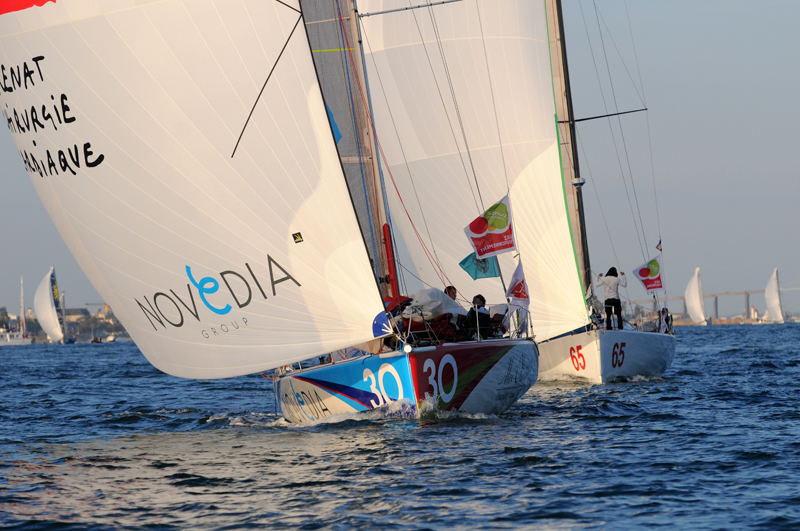
Over the weekend, the more easterly boats in the northern group of the fleet tucked into the Trade Winds while the western pack have yet to taste the north-east breeze. Although the endless headwinds have ceased, the 12 days of slamming upwind left a legacy for Giovanni Soldini and Pietro d’Ali on Telecom Italia with the failure of the upper swivel on their forestay furler. Fortunately, as the headstay crashed to the deck, the inner forestay held the mast in place and in the 0800 GMT position poll this morning, the Italian duo are making just over eight knots, 52 miles behind the race leader.
South of Telecom Italia, the current race leader, Tanguy de Lamotte and Adrien Hardy on Initiatives-Novedia have crossed the Mid-Atlantic Ridge and at the same latitude as the southern tip of Florida the French duo are continuing south-west towards the mandatory race gate off the island of St. Barts making the best speed in the northern group of 12.5 knots in approximately 16 knots of south-easterly breeze. Behind the race leader by 92 miles, Bruno Jourdren and Bernard Stamm on Cheminées Poujoulat in 3rd and Damien Seguin and Armel Tripon on 4th placed Cargill-MTTM have finally separated after sailing in close formation for the majority of the past week with Seguin and Tripon opting to drop south on Sunday afternoon and slipstream Initiatives-Novedia. Since this move south, Jourdren and Stamm on Cheminées Poujoulat have built a 30 mile lead over their French rivals on Cargill-MTTM with both boats currently averaging 11 knots.
Separated by just over 100 miles and in the same ESE breeze of around 16 knots, the Anglo-Australian team of Tim Wright and Nicholas Brennan on Sail4Cancer hold 5th place with a 61 mile lead over Peter Harding and Miranda Merron on 40 Degrees with the Finnish duo of Jouni Romppanen and Sam Öhman on Tieto in 7th currently 44 miles off the starboard quarter of 40 Degrees while Harding and Merron average the best speed in the trio of 11.6 knots.

Flanking the main body of the fleet, Felipe Cubillos and Daniel Bravo Silva in 8th on Desafio Cabo de Hornos hold the northern station while Denis Lazat and Frédéric Nouel on PLAN in 10th maintain their southern position and are enjoying the Trade Winds, while the Chileans in the north must wait a little longer for the north-easterly breeze. In 9th place, 588 mile behind the lead boat, Jacques Fournier and Jean-Edouard Criquioche on Groupe Picoty have taken the northerly option and, like the Chilean duo, will have to wait for the Trades while Stephen Card and Shaun Murphy on ORBIS further south in 11th reported earlier that they have already entered the north-easterly breeze.
Meanwhile, furthest north in the fleet, Patrice Carpentier and Victor Maldonado on Crédit Maritime in 15th place are in the grips of the Azores High which has returned to its traditional location over the remote group of islands and Yves Eclaret and Lionel Regnier, the fleet’s back markers on Vale Inco Nouvelle Calédonie, may have just linked with the Trade Winds. The southern group in the fleet are currently converging on the northern pack with Erik Nigon and Marc Jouany on Axa Atout Coeur Pour Aides in 12th place 712 miles behind the lead boat and 113 miles now separate Nigon and Jouany, David Consorte and Aubry Arnaud in 13th on Adriatech and Mike West and Paul Worswick on Keysource in 14th place with the British duo continuing to poll the highest speed average in the fleet at 13 knots.
Desafio Cabo de Hornos
“We don’t know how much wind we have but I think it’s around 20 knots and we’re reaching at 90 degrees, so we’re going quite fast, it’s comfortable and everything is fine. I think we’re going to sail more together with the rest of the fleet although I think, more or less, we’ll keep our position. We’re in perfect condition, we’ve slept well and we’re sailing in a direction so the boat isn’t slamming all of the time.”
The Mayas were the first to cultivate the cocoa bean in the 17th century BC on the Yucatan peninsula in Mexico. The divine drink xocoatl made from cocoa was said to nourish man after death, and its life-giving and aphrodisiac properties were already well known. Beans were dried, ground, mixed with hot water and then flavoured with chilli, spices or vanilla.
Spaniard Hernan Cortés disembarked in Mexico in 1519, conquering the New World. He was received like a God. He discovered xocoatl.
When Cortés returned to Spain in 1528, he described the virtues of this new beverage to King Charles I of Spain: “One cup of this precious drink enables a man to walk for an entire day without eating.”
The first commercial cocoa cargos reached Spain in 1585 but it was not until the time of Anne of Austria, Queen of Louis XIII of France and daughter of the King of Spain, that the drink reached France. Courtesans in Versailles adored chocolate.

Solidaire du Chocolat